
Bhutan's early history is steeped in mythology and remains obscure. Some of the structures provide evidence that the region has been settled as early as 2000 BC. According to a legend it was ruled by a Cooch-Behar king, Sangaldip, around the 7th century BC, but not much is known prior to the introduction of Tibetan Buddhism in the 9th century, when turmoil in Tibet forced many monks to flee to Bhutan. In the 12th century, the Drukpa Kagyupa school was established and remains the dominant form of Buddhism in Bhutan today. The country's political history is intimately tied to its religious history and relations among the various monastic schools and monasteries.
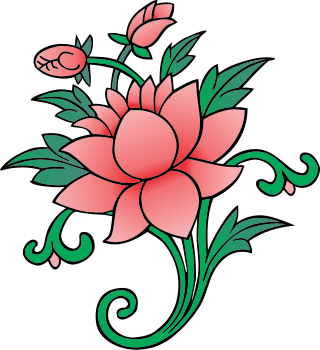
The Drukpa or Drukpa Kagyu lineage, sometimes called Dugpa in older sources, is a branch of the Kagyu school of Tibetan Buddhism. The Kagyu school is one of the Sarma or "New Translation" schools of Tibetan Buddhism. The Drukpa lineage was founded in the Tsang region of Tibet by Tsangpa Gyare (1161–1211), and later became influential in Ladakh and Bhutan. It is one of several lineages known as "Red Hat sects".
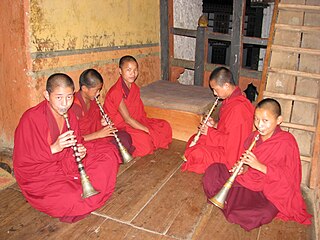
The music of Bhutan is an integral part of its culture and plays a leading role in transmitting social values. Traditional Bhutanese music includes a spectrum of subgenres, ranging from folk to religious song and music. Some genres of traditional Bhutanese music intertwine vocals, instrumentation, and theatre and dance, while others are mainly vocal or instrumental. The much older traditional genres are distinguished from modern popular music such as rigsar.

Ngawang Namgyal (1594–1651), known colloquially as The Bearded Lama, was a Tibetan Buddhist Drukpa Kagyu school Rinpoche, and the unifier of Bhutan as a nation-state. He was later granted the honorific title Zhabdrung Rinpoche, approximately "at whose feet one submits"). In addition to unifying the various warring fiefdoms for the first time in the 1630s, he also sought to create a distinct Bhutanese cultural identity separate from the Tibetan culture from which it was derived.
Articles related to Bhutan include:

Zhabdrung was a title used when referring to or addressing great lamas in Tibet, particularly those who held a hereditary lineage. In Bhutan the title almost always refers to Ngawang Namgyal (1594–1651), the founder of the Bhutanese state, or one of his successive reincarnations.

Chagri Dorjeden Monastery, also called Cheri Monastery, is a Buddhist monastery in Bhutan established in 1620 by Ngawang Namgyal, 1st Zhabdrung Rinpoche, the founder of the Bhutanese state.
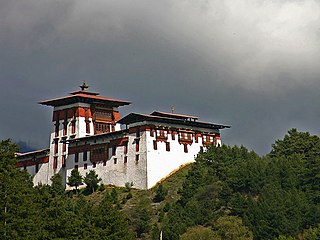
Jakar Dzong or Jakar Yugyal Dzong is the dzong or fortress of the Bumthang District in central Bhutan. It is located on a ridge above Jakar town in the Chamkhar valley of Bumthang. It is built on the site of an earlier temple established by the Ralung hierarch Yongzin Ngagi Wangchuk (1517–1554) when he came to Bhutan. Jakar Dzong may be the largest dzong in Bhutan, with a circumference of more than 1,500 metres (4,900 ft).

The Penlop of Trongsa, also called Chhoetse Penlop, is a Dzongkha title meaning "Governor of the Province of Trongsa (Chhoetse)". It is now generally given to the heir apparent of the Kingdom of Bhutan, but historically was an important title, for the governor of Trongsa and the surrounding area, and was the route by which the House of Wangchuck came to the throne.

The Tango Monastery is a Buddhist monastery located 14 kilometres (8.7 mi) to the north of the capital city of Thimphu in Bhutan, near Cheri Mountain. It was founded by Phajo Drugom Zhigpo in the 13th century and built in its present form by Tenzin Rabgye, the 4th Temporal Ruler in 1688. In 1616, the Tibetan lama Shabdrung Ngawang Namgyal meditated in its cave. The self-emanated form of the wrathful Hayagriva is deified in the monastery. It belongs to the Drukpa Kagyu School of Buddhism in Bhutan.

Tsangpa was a dynasty that dominated large parts of Tibet from 1565 to 1642. It was the last Tibetan royal dynasty to rule in their own name. The regime was founded by Karma Tseten, a low-born retainer of the prince of the Rinpungpa dynasty and governor of Samdrubtsé in Tsang since 1548.

Simtokha Dzong also known as Sangak Zabdhon Phodrang is a small dzong. It was built in 1628 by Zhabdrung Ngawang Namgyal, who unified Bhutan. It is the first of its kind built in Bhutan. An important historical monument and former Buddhist monastery, today it houses one of the premier Dzongkha language learning institutes. It recently underwent renovation.
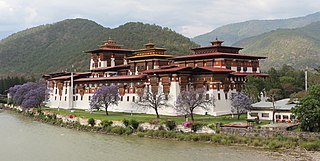
The Punakha Dzong, also known as Pungthang Dewa chhenbi Phodrang, is the administrative centre of Punakha District in Punakha, Bhutan. Constructed by Ngawang Namgyal, 1st Zhabdrung Rinpoche, in 1637–38, it is the second oldest and second-largest dzong in Bhutan and one of its most majestic structures. The dzong houses the sacred relics of the southern Drukpa Lineage of the Kagyu school of Tibetan Buddhism, including the Rangjung Kharsapani and the sacred remains of Ngawang Namgyal and the tertön Pema Lingpa.
Dondup Tseten Dorje was the penultimate prince of the Rinpungpa Dynasty which held power in Tsang between 1435 and 1565. The details about his reign, and his exact years in power, are relatively obscure.
Karma Phuntsok Namgyal was a king of Tibet who ruled from 1618 to 1620. He belonged to the Tsangpa Dynasty that held power in Tsang since 1565 and was the foremost political and military power in Tibet until 1642.
Karma Tenkyong, in full Karma Tenkyong Wangpo, was a king of Tibet who ruled from 1620 to 1642. He belonged to the Tsangpa Dynasty which had been prominent in Tsang since 1565. His reign was marked by the increasingly bitter struggle against the Gelugpa sect and its leader the Dalai Lama. The outcome was the crushing of the Tsangpa regime and the establishment of the Dharma-based Tibetan state that endured until 1950.
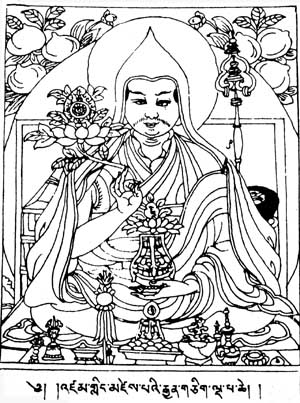
The Dual System of Government is the traditional diarchal political system of Tibetan peoples whereby the Desi coexists with the spiritual authority of the realm, usually unified under a third single ruler. The actual distribution of power between institutions varied over time and location. The Tibetan term Cho-sid-nyi literally means "both Dharma and temporal," but may also be translated as "dual system of religion and politics."
The Kingdom of Bumthang was one of several small kingdoms within the territory of modern Bhutan before the first consolidation under Zhabdrung Ngawang Namgyal in 1616. After initial consolidation, the Bumthang Kingdom became Bumthang Province, one of the nine Provinces of Bhutan. The region was roughly analogous to modern-day Bumthang District. It was again consolidated into the modern Kingdom of Bhutan in 1907.

The military history of Bhutan begins with the Battle of Five Lamas in 1634, marking Bhutan's emergence as a nation under the secular and religious leadership of Zhabdrung Ngawang Namgyal. Before Bhutan emerged as a separate nation, it remained on the periphery of Tibetan military and political influence. The region that became Bhutan was host to several battles and waves of refugees from turmoil in Tibet. After its founding, Bhutan was invaded numerous times by outside forces, namely Tibetans, Mongols, and the British. Bhutan meanwhile invaded its traditional tributaries in Sikkim, Cooch Behar, and the Duars.
Gaeboo Achyok or Gyalpo Ajok was a Lepcha chieftain of a principality based at Damsang, presently in the Kalimpong district of West Bengal, India.

















